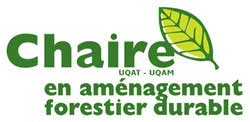
Hugo Asselin détient un baccalauréat en biologie avec concentration en écologie de l'Université de Sherbrooke (1997), une maîtrise en sciences biologiques (écologie forestière) de l'Université de Montréal (1999) et un doctorat en biologie (paléoécologie) de l'Université Laval (2005). À l'UQAT depuis 2004, il a d'abord complété un stage postdoctoral en paléoécologie, avant de joindre l'équipe de professeurs du département des sciences du développement humain et social en 2007, et de l'École d'études autochtones en 2016. Depuis 2008, il est titulaire de la CHAIRE EN FORESTERIE AUTOCHTONE et depuis 2020, il est également titulaire de la CHAIRE DESJARDINS EN DÉVELOPPEMENT DES PETITES COLLECTIVITÉS. Chercheur régulier au Centre d'étude de la forêt (CEF) et au Réseau de recherche et de connaissances relatives aux peuples autochtones (DIALOG), ses intérêts de recherche portent sur la foresterie sociale et autochtone, l'écologie forestière, la paléoécologie, la dendrochronologie et l'anthracologie.
Axes de Recherche
- Identifier, documenter et expliquer les enjeux et défis sociaux, culturels, économiques, politiques et environnementaux auxquels font face les communautés autochtones en réponse à l'aménagement forestier réalisé sur leurs territoires ancestraux et proposer et expérimenter des approches novatrices pour aider les communautés autochtones à faire face à ces défis et enjeux.
- Documenter et valoriser les savoirs traditionnels en lien avec la forêt.
- Reconstituer la dynamique holocène des écosystèmes forestiers boréaux en réponse aux changements climatiques ainsi qu'aux perturbations naturelles et anthropiques.
Étudiant(e)s de maîtrise et doctorat recherché(e)s
Je recrute régulièrement de nouveaux étudiants de maîtrise et de doctorat pour travailler sur des projets touchant la foresterie sociale et autochtone, l'écologie forestière et la paléoécologie. Veuillez me contacter pour plus de détails.
Autres sites à consulter :
Centre d'étude de la forêt (CEF) Site départemental-UQAT GoogleScholar ResearchGate ORCID Annie Claude Bélisle, Chrystal Mantyka-Pringle, Yan Boulanger, Benoit Crôteau, Alice Wapachee, Louis-Joseph Drapeau, Mélanie Desrochers, Hugo Asselin. Indigenous knowledge, forest landscape modeling, and the cumulative effects of environmental changes 2025. Ecological applications e70053
DOI : https://doi.org/10.1002/eap.70053
Nina Ryzhkova, Hugo Asselin, Adam A. Ali, Alexander Kryshen, Yves Bergeron, Daniela Robles, Sara Pineda-Zapata, Igor Drobyshev. PDO Dynamics Shape the Fire Regime of Boreal Subarctic Landscapes in the Northwest Territories, Canada 2025. Journal of Geophysical Research: Biogeosciences e2024JG008178
DOI : 10.1029/2024JG008178
Marianne Vogel, Sébastien Joannin, Mebarek Lamara, Hugo Asselin, Adam A. Ali, Sabrina Leclercq, Cécile Latapy, Frank Richard, Yves Bergeron. Multi-proxy analysis of early Holocene vegetation dynamics on the islands of proglacial Lake Ojibway (northeastern America) 2024. Journal of Quaternary Science 229-242
DOI : 10.1002/jqs.3682
Delphine Théberge, Maude Flamand-Hubert, Solange Nadeau, Julie Girard, Isabelle Bradette, Hugo Asselin. Forest-Based Health Practices: Social Representations of Nature and Favorable 2024. Forests 1886
DOI : 10.3390/f15111886
Limoilou-Amélie Renaud, Hugo Asselin. Détecter l’invisible : le potentiel écologique de l’ADN environnemental 2024. Le Couvert Boréal 42
Kloé Chagnon-Taillon, Hugo Asselin, Jérôme Dupras. La culture, un élément clé de la protection des territoires Autochtones 2024. Le Couvert Boréal 22
Éliane Grant, Nicole J. Fenton, Hugo Asselin. Les milieux humides : un élément central de la relation entre les Autochtones et l’orignal 2024. Le Couvert Boréal 10
Maxime Thomas, Yan Boulanger, Hugo Asselin, Mebarek Lamara, Nicole J. Fenton. How will climate change and forest harvesting influence the habitat quality of 2024. Science of the Total Environment 172148
DOI : 10.1016/j.scitotenv.2024.172148
Marianne Vogel, Adam A. Ali, Sébastien Joannin, Yves Bergeron, Hugo Asselin. Postglacial vegetation migration facilitated by outposts on proglacial lake islands in eastern North America 2024. Quaternary Science Advances 100164
DOI : 10.1016/j.qsa.2024.100164
Maxime Thomas, Mebarek Lamara, Hugo Asselin, Nicole J. Fenton. Effects of industrial disturbances on the flavonoid concentration of Rhododendron groenlandicum. 2023. Botany 343-356
DOI : 10.1139/cjb-2022-0136
DOCTORANT
MAîTRISE
STAGIAIRE
1-01. Régime des feux et dynamique naturelle de la forêt boréale de l’est du Canada.
1-07. Impacts socio-écologiques de l'altération des forêts mixtes boréales.
5-09. Cadre de développement durable et intégré d'une forêt de proximité.
5-10. Gestion multiressource et intégrée des forêts de proximité en contexte autochtone.
5-11. Rôle et place des femmes autochtones dans la gouvernance du territoire et des ressources.
Limoilou-Amélie Renaud, Hugo Asselin. Perspectives multiples sur l'utilisation de l'ADN environnemental pour les suivis de la biodiversité 26e colloque de la Chaire AFD. Hôtel Forestel, Val-d'Or, Québec. (2024-11-20)
Marion Blache, Dorian Gaboriau, Hugo Asselin, Sébastien Joannin, Jean-Sepet Mathis, Martin-Philippe Girardin, Pierre J.H. Richard, Yves Bergeron, Adam A. Ali. Holocene rise and fall of pine in Quebec's northern temperate forest was controlled by fire 26e colloque de la Chaire AFD. Hôtel Forestel, Val-d'Or, Québec. (2024-11-20)
Kloé Chagnon-Taillon, Hugo Asselin, Jean-François Bissonnette, Jérôme Dupras. L'approche par services écosystémiques comme outil de gestion et de gouvernance en aires protégées au Québec 17e colloque annuel du CEF, Université du Québec en Outaouais (2024-05-03)
Dorian Gaboriau, Marianne Vogel, Jordan Paillard, Hugo Asselin, Adam A. Ali, Yves Bergeron. Histoire à long terme de la dynamique de la végétation et des incendies aux plus hautes altitudes du nord-ouest du Québec, Canada 17e colloque annuel du CEF, Université du Québec en Outaouais (2024-05-02)
Kloé Chagnon-Taillon, Hugo Asselin, Jérôme Dupras. Combiner les arts et la science pour cartographier les territoires autochtones : Cas du bassin versant de la rivière Broadback en territoire cri (Eeyou Istchee) 3e rencontre annuelle du Laboratoire International de Recherche sur les Forêts Froides. Station touristique Duchesnay, Québec. (2023-10-04)
Guillaume Proulx, Hugo Asselin. Évaluer et atténuer le risque de feux de forêt par les paysages vulnérables : une méthodologie exploratoire en Eeyou Istchee – Baie-James 3e rencontre annuelle du Laboratoire International de Recherche sur les Forêts Froides. Station touristique Duchesnay, Québec. (2023-10-04)
Maxime Thomas, Yan Boulanger, Hugo Asselin, Mebarek Lamara, Nicole J. Fenton. Comment les changements climatiques et l'exploitation forestière influenceront-ils la présence de deux plantes d’importance culturelle ? 3e rencontre annuelle du Laboratoire International de Recherche sur les Forêts Froides. Station touristique Duchesnay, Québec. (2023-10-04)
Marion Lacand, Hugo Asselin, Damien Rius, Marianne Vogel, Adam A. Ali. Les feux peuvent-ils induire des épisodes d'érosion dans les bassins versants du nord de la Finlande ? 3e rencontre annuelle du Laboratoire International de Recherche sur les Forêts Froides. Station touristique Duchesnay, Québec. (2023-10-03)
Marianne Vogel, Adam A. Ali, Sébastien Joannin, Yves Bergeron, Hugo Asselin. Facilitation de la migration postglaciaire végétale par les avant-postes insulaires d’un lac proglaciaire en Amérique du Nord-Est. 3e rencontre annuelle du Laboratoire International de Recherche sur les Forêts Froides. Station touristique Duchesnay, Québec. (2023-10-03)
Maxime Thomas, Yan Boulanger, Hugo Asselin, Mebarek Lamara, Nicole J. Fenton. Quel avenir pour les espèces culturelles clés sous l’effet du changement climatique et de la coupe? 16e colloque annuel du CEF, Université de Montréal (2023-05-08)
Marianne Vogel, Sébastien Joannin, Adam A. Ali, Yves Bergeron, Edith Leclerc, Cécile Latapy, Hugo Asselin. Les premières étapes de la végétation d’anciennes îles du lac Ojibway (Abitibi, Québec) au début de l’Holocène 16e colloque annuel du CEF, Université de Montréal (2023-05-08)
Marianne Vogel, Adam A. Ali, Hugo Asselin, Sabrina Leclercq, Cécile Latapy, Sébastien Joannin, Yves Bergeron. Histoire des paléo-îles du lac proglaciaire Ojibway
(Abitibi, Québec)
premières étapes de la végétation 24e colloque de la Chaire AFD. Université du Québec en Abitibi-Témiscamingue, Rouyn-Noranda, Québec. (2022-11-22)
Maxime Thomas, Hugo Asselin, Mebarek Lamara, Nicole J. Fenton. Effet des perturbations humaines sur les propriétés médicinales de R. groenlandicum 24e colloque de la Chaire AFD. Université du Québec en Abitibi-Témiscamingue, Rouyn-Noranda, Québec. (2022-11-22)
Kloé Chagnon-Taillon, Hugo Asselin, Jérôme Dupras. Combiner les arts et la science pour cartographier les territoires autochtones 15e colloque annuel du CEF, Université de Sherbrooke, Québec (2022-09-28)
Maxime Thomas, Hugo Asselin, Mebarek Lamara, Nicole J. Fenton. Impact of industrial disturbances on the chemical properties of Rhododendron groenlandicum in three Indigenous communities of western Québec Conférence annuelle de l’Association Botanique Canadienne. Université du Québec en Abitibi-Témiscamingue, Rouyn-Noranda, Québec. (2022-06-08)
Chloé Pelletier, Benoit Éthier, Hugo Asselin. Transmission des savoirs et utilisation des bleuets par les femmes Atikamekw Nehirowiskewok de Wemotaci (Qc, Canada) Conférence annuelle de l’Association Botanique Canadienne. Université du Québec en Abitibi-Témiscamingue, Rouyn-Noranda, Québec. (2022-06-06)
Éliane Grant, Hugo Asselin. Connaissances traditionnelles autochtones sur les milieux humides en eeyou istchee - Baie-James et la sante de l'orignal comme indicateur de détérioration de son habitat. 3e colloque annuel de la Chaire industrielle CRSNG-UQAT sur la biodiversité en contexte minier. Université du Québec en Abitibi-Témiscamingue, Rouyn-Noranda, Québec. (2022-04-22)
Maxime Thomas, Hugo Asselin, Mebarek Lamara. Vulnérabilité d'espèces culturelles clés aux impacts cumulatifs des changements environnementaux 3e colloque annuel de la Chaire industrielle CRSNG-UQAT sur la biodiversité en contexte minier. Université du Québec en Abitibi-Témiscamingue, Rouyn-Noranda, Québec. (2022-04-20)
Annie Claude Bélisle, Hugo Asselin. Allier modélisation et savoirs autochtones. Série de webinaires sur l'analyse intégrée régionale des impacts des changements climatiques sur la forêt du Québec organisée par le Service canadien des forêts (2021-02-10)
Julia Morarin, Hugo Asselin. Les communautés Autochtones face aux saisons de feux extrêmes, Canada 21e colloque de la Chaire AFD. Université du Québec en Abitibi-Témiscamingue, Rouyn-Noranda, Québec. (2019-11-30)
